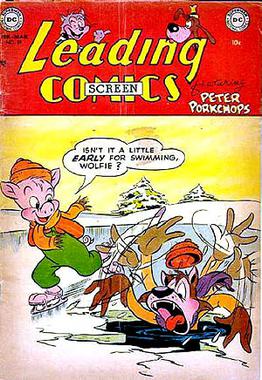
A superhero or superheroine is a stock character that possesses superpowers, abilities beyond those of ordinary people, and fits the role of the hero, typically using his or her powers to help the world become a better place, or dedicating themselves to protecting the public and fighting crime. Superhero fiction is the genre of fiction that is centered on such characters, especially, since the 1930s, in American comic books, as well as in Japanese media.
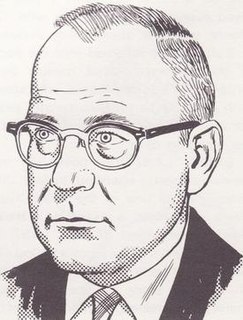
Gardner Francis Cooper Fox was an American writer known best for creating numerous comic book characters for DC Comics. Comic book historians estimate that he wrote more than 4,000 comics stories, including 1,500 for DC Comics. Fox was also a science fiction author and wrote many novels and short stories.
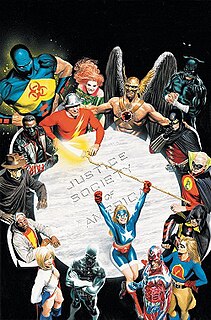
The Justice Society of America (JSA) is a superhero team appearing in American comic books published by DC Comics. The team was conceived by editor Sheldon Mayer and writer Gardner Fox during the Golden Age of Comic Books. The JSA first appeared in All Star Comics #3, making it the first team of superheroes in comic books. The original members of the Justice Society of America were Doctor Fate, Hourman, The Spectre, Sandman, Atom, Flash, Green Lantern, and Hawkman.
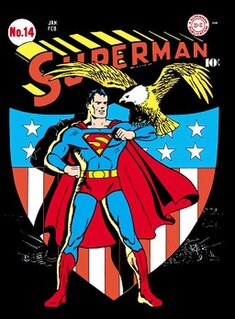
The Golden Age of Comic Books describes an era of American comic books from 1938 to 1956. During this time, modern comic books were first published and rapidly increased in popularity. The superhero archetype was created and many well-known characters were introduced, including Superman, Batman, Captain Marvel, Captain America, and Wonder Woman.

Starman is a name used by several different DC Comics superheroes, most prominently Ted Knight and his sons David and Jack.

The All-Star Squadron is a DC Comics superhero team that debuted in Justice League of America #193 and was created by Roy Thomas, Rich Buckler and Jerry Ordway. Although the team was introduced in the 1980s, its self-titled series took place in the 1940s, retroactively inserting their narratives into the fictional history of the DC Comics superheroes. The team included many of DC's Golden Age era characters, new characters, and other World War II superheroes that DC did not own during the 1940s but later acquired. The name "All-Star Squadron" was creator Roy Thomas' reference to All Star Comics, the series that introduced the Justice Society of America, the first comic book superhero team.

An American comic book is a thin periodical originating in the United States, on average 32 pages, containing comics. While the form originated in 1933, American comic books first gained popularity after the 1938 publication of Action Comics, which included the debut of the superhero Superman. This was followed by a superhero boom that lasted until the end of World War II. After the war, while superheroes were marginalized, the comic book industry rapidly expanded and genres such as horror, crime, science fiction and romance became popular. The 1950s saw a gradual decline, due to a shift away from print media in the wake of television and the impact of the Comics Code Authority. The late 1950s and the 1960s saw a superhero revival and superheroes remained the dominant character archetype throughout the late 20th century into the 21st century.

Flash Comics is a comics anthology published by All-American Publications and later by National Periodical Publications. The title had 104 issues published from January 1940 to February 1949. Despite the title, the anthology featured the adventures of multiple superheroes in addition to Jay Garrick, the original Flash. Characters introduced in the series include the Flash, Hawkman, Hawkgirl and Black Canary.

All Star Comics is an American comic book series from All-American Publications, one of three companies that merged with National Periodical Publications to form the modern-day DC Comics. While the series' cover-logo trademark reads All Star Comics, its copyrighted title as indicated by postal indicia is All-Star Comics, with a hyphen. With the exception of the first two issues, All Star Comics told stories about the adventures of the Justice Society of America, the very first team of superheroes. It also introduced Wonder Woman.

The Seven Soldiers of Victory is a team of fictional comic book superheroes in the DC Comics universe. They first appeared in Leading Comics #1, and were created by Mort Weisinger and Mort Meskin. The team was a short-lived assembly of some of the less famous superheroes in the DC Universe who have made occasional appearances since their Golden Age debut.
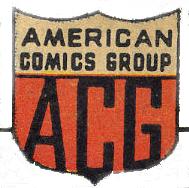
American Comics Group (ACG) was an [American comic book publisher started in 1939 and existing under the ACG name from 1943 to 1967. It published the medium's first ongoing horror-comics title, Adventures into the Unknown. ACG's best-known character was the 1960s satirical-humor hero Herbie Popnecker, who starred for a time in Forbidden Worlds. Herbie would later get his own title and be turned into a "superhero" called the Fat Fury.

The Mighty Crusaders is a fictional superhero team published by Archie Comics. The team originally appeared in Fly-Man No. 31, #32 and No. 33 before being launched in its own title, Mighty Crusaders. Written by Superman co-creator Jerry Siegel, the series lasted seven issues before being cancelled. The team was revived under Archie's Red Circle Comics line in 1983. In 1992 DC Comics licensed the characters and relaunched the team as The Crusaders, aiming the comic at younger readers as part of its !mpact line. This series lasted eight issues, cover-dated May to December 1992.

Dark Circle Comics is an imprint of Archie Comics Publications, Inc. Under its previous name, Red Circle Comics, it published non-humor characters, particularly superheroes in the 1970s and 1980s, and was a digital imprint from 2012 to 2014. In 2015, it was converted back to a print imprint and was completely revamped as Dark Circle Comics, featuring darker and more mature content than previous incarnations of Archie's superhero line.
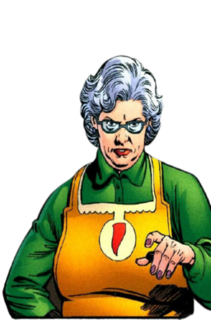
Abigail Mathilda "Ma" Hunkel is a fictional character, and occasionally a superheroine in the DC Comics Universe, debuting during the Golden Age of Comic Books. Created by Sheldon Mayer, she first appeared in her civilian identity as in All-American Publications' All-American Comics #3, and became the first character to be known as the Red Tornado in All-American Comics #20. As the Red Tornado, she was one of the superhero parodies, as well as one of the first female superheroes and is the first cross-dressing heroine.

Sheldon Mayer was an American comics artist, writer, and editor. One of the earliest employees of Major Malcolm Wheeler-Nicholson's National Allied Publications, Mayer produced almost all of his comics work for the company that would become known as DC Comics.
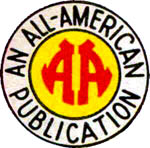
All-American Publications was one of two American comic book companies that merged to form the modern day DC Comics, one of the two largest publishers of comic books in the United States. Superheroes created for All-American include the original Atom, Flash, Green Lantern, Hawkman, and Wonder Woman, all in the 1940s' Golden Age of Comic Books.

Al Pratt is a fictional character appearing in American comic books published by DC Comics and the original hero to fight crime as the Atom. He initially had no superpowers; instead, he was a diminutive college student and later a physicist, usually depicted as a "tough-guy" character.

Hourman is a fictional superhero appearing in comics published by DC Comics. He is known as the original Hourman. He was created by writer Ken Fitch and artist Bernard Baily in Adventure Comics #48, during the Golden Age of Comic Books. He continued to appear in Adventure Comics until issue #83.

Magazine Enterprises was an American comic book company lasting from 1943 to 1958, which published primarily Western, humor, crime, adventure, and children's comics, with virtually no superheroes. It was founded by Vin Sullivan, an editor at Columbia Comics and before that the editor at National Allied Publications, the future DC Comics.

Western comics is a comics genre usually depicting the American Old West frontier and typically set during the late nineteenth century. The term is generally associated with an American comic books genre published from the late 1940s through the 1950s. Western comics of the period typically featured dramatic scripts about cowboys, gunfighters, lawmen, bounty hunters, outlaws, and Native Americans. Accompanying artwork depicted a rural America populated with such iconic images as guns, cowboy hats, vests, horses, saloons, ranches, and deserts, contemporaneous with the setting.

